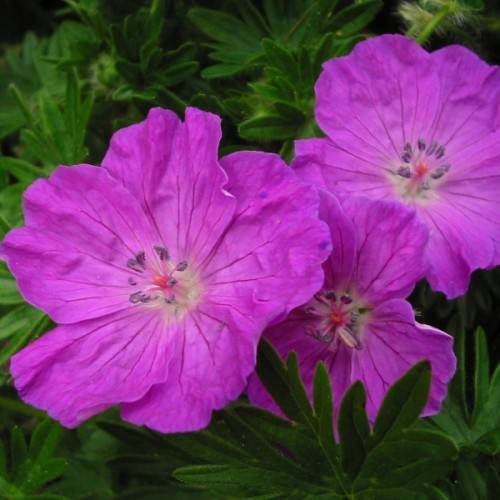
geranium
Geranium spp. and/ or cvs.
Also Known As - cranesbillCycle:
Perennial
Watering:
Average
Hardiness Zone:
5
Flowers:
Flowers In Spring
Sun:
Full sun
Soil:
Well-drained
Fruits:
Fruits In Summer Ready In Summer
Leaf:
Yes
Growth Rate:
Moderate
Maintenance:
Low
Drought Tolerant:
Yes
Salt Tolerant:
Yes
Thorny:
Yes
Invasive:
Yes
watering
Spreading broom (Genista pilosa) should be watered approximately once a week, depending on its growing conditions. They require even and consistent moisture, so it is important to check the soil moisture before watering. If the soil is already quite damp, then you don’t need to water it right away. When watering, make sure to soak the whole root system of the plant, but avoid over-watering. Too much water can cause root rot, and too little water can cause the plant to dry out and die.
sunlight
Spreading broom (Genista pilosa) prefers areas with full sun, at least 6 hours a day. It can tolerate some shade, but will flower best in full sun. In some regions with hot summers, it can handle full sun all day long. During its flowering period, it may benefit from some afternoon shade in areas with hot summers. In winter, full sun is beneficial for spreading broom, especially in areas that stay relatively warm in the winter.
pruning
The ideal time for pruning Genista pilosa is during late winter or early spring before new growth begins. Prune by removing any dead, diseased, or damaged branches. Also, thin overcrowded stems by cutting them back to the ground. This type of plant can tolerate moderate pruning to help maintain its shape and size. However, avoid cutting back more than 1/3 of the plant at once to reduce the stress on the plant and its root system.
Season
Hardiness Map
FAQ
Do Geraniums bloom all year round?
No, geraniums do not bloom all year round. They tend to be more of a seasonal plant; typically blooming in the warmer spring and summer months before dying off in the cooler fall and winter. Depending on what type of geranium you have, they may or may not survive the winter months. If they do survive, they may not have any blooms until the next spring.
Can geraniums be propagated by seeds?
Yes, geraniums can be propagated by seeds. Geraniums have small, hard seeds that need to be stratified (cold-treated) in order to germinate. To do this, the seeds should be soaked in warm water for at least 24 hours before being placed in the refrigerator for 10 days. After this, they can be rinsed and sowed in germinating medium or seed starting mix. Depending on the variety and the temperatures, geranium seeds can take between 2 to 6 weeks to germinate.
Could geraniums grow in hydroponics?
Yes, geraniums are a great plant to grow with hydroponics. Geraniums need plenty of air to breathe and adequate water and nutrients, which can all be provided in a hydroponic system. Since they require well-drained soil, they would benefit from the aeration and moist environment of a hydroponic setup. Moreover, as they prefer warm temperatures, they would likely thrive under the warmth of hydroponic lights. To make sure they are adequately fertilized, you should use a hydroponic fertilizer that is specifically designed for geraniums.
Should geraniums be placed in a windy location?
No, geraniums should not be placed in a windy location. Windy locations can cause the delicate leaves of a geranium to dry out, leading to discoloration, drying and yellowing of leaves. Additionally, the wind can cause the fragile stems to snap, leading to weakened and unhealthy plants. To avoid this, geraniums should be planted in an area sheltered from strong winds and gusts, where they can get some air flow but not be exposed to strong, destructive winds.
Is the geranium annual or a perennial?
The geranium is both an annual and a perennial, depending on the type. Annual geraniums last one year and die after flowering. Perennial geraniums are more cold hardy and can survive for more than one growing season. Perennial geraniums need to be divided and replanted every few years to keep them healthy.
Can geraniums survive in cold temperatures?
No, geraniums are not able to survive in cold temperatures and are generally sensitive to cold weather. In fact, they typically start to die off below 40°F and any temperatures below 32°F can be fatal. If temperatures dip too low, it is important to move geraniums indoors to protect them from the cold.
Can geraniums be grown indoors?
Yes, geraniums can be grown indoors. They are a very popular and easy to maintain houseplant. They prefer bright but indirect light, so a south-facing window is best, but away from direct sunlight. They need well-draining, moist soil and should be watered once or twice a week, taking care not to overwater. Geraniums can be propagated easily by taking cuttings, and they will reward your care with a great display of vibrant blooms.
Should geraniums be grown in plastic or clay pots?
Geraniums should be grown in clay pots or ceramic pots. Clay pots provide better drainage for the plant and help to keep the soil aerated, which is important for geraniums. Plastic pots tend to retain more moisture, which can cause root rot in geraniums and cause them to die. Plastic pots can also get very hot in the summer, causing the plant to get too much sun exposure and become damaged. Because of this, it's safest to grow geraniums in a clay or ceramic pot.
